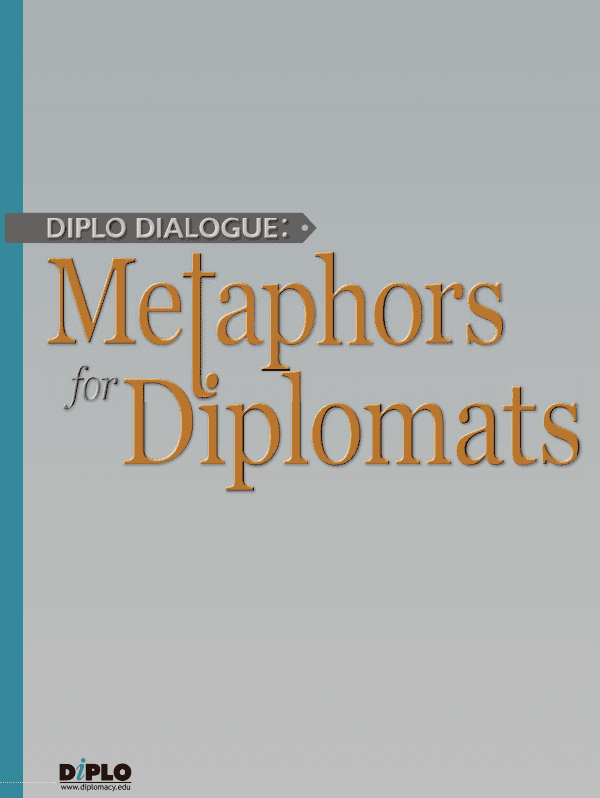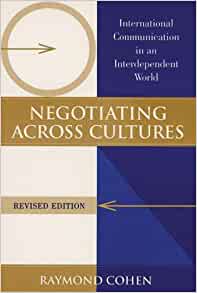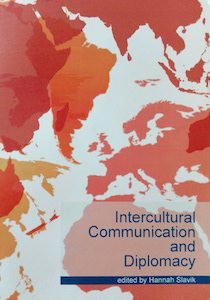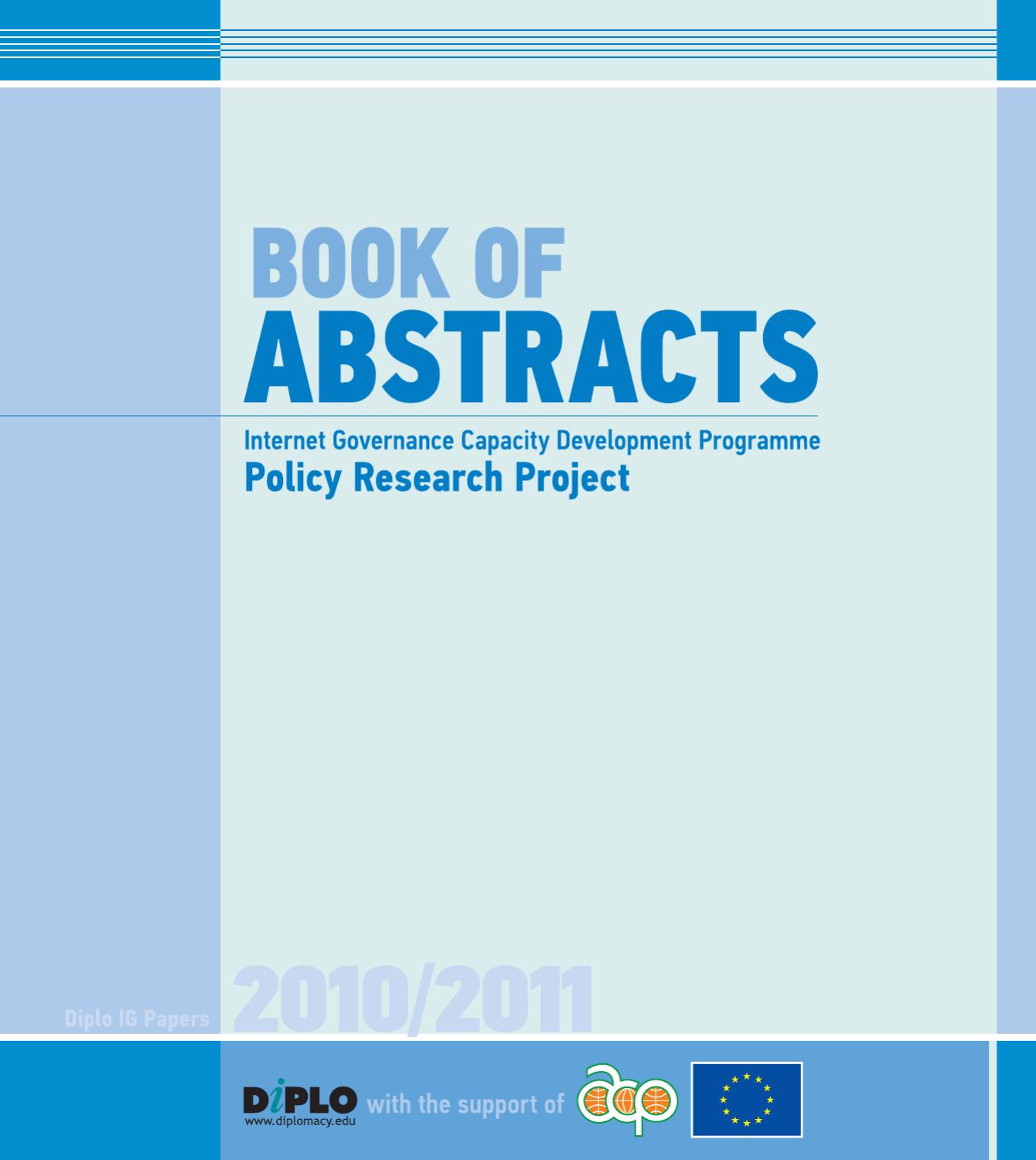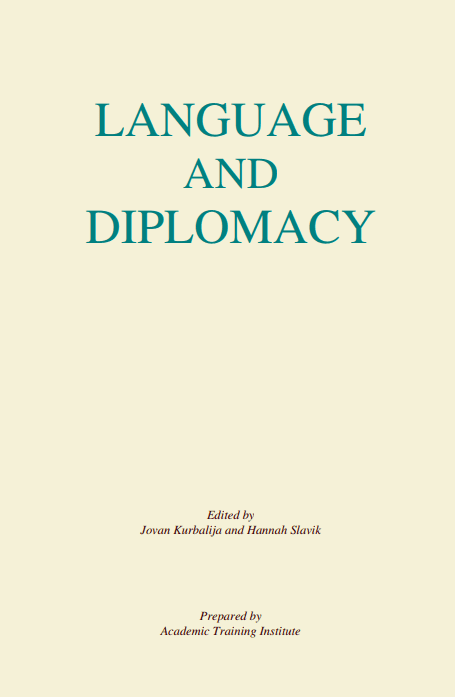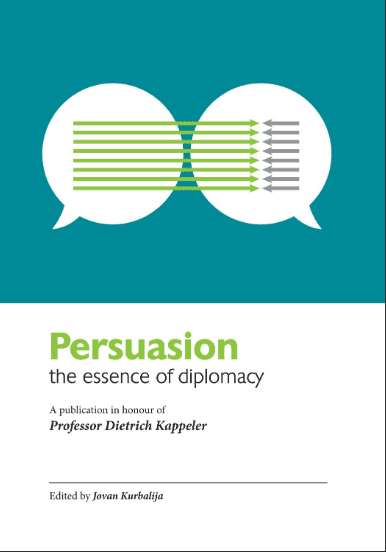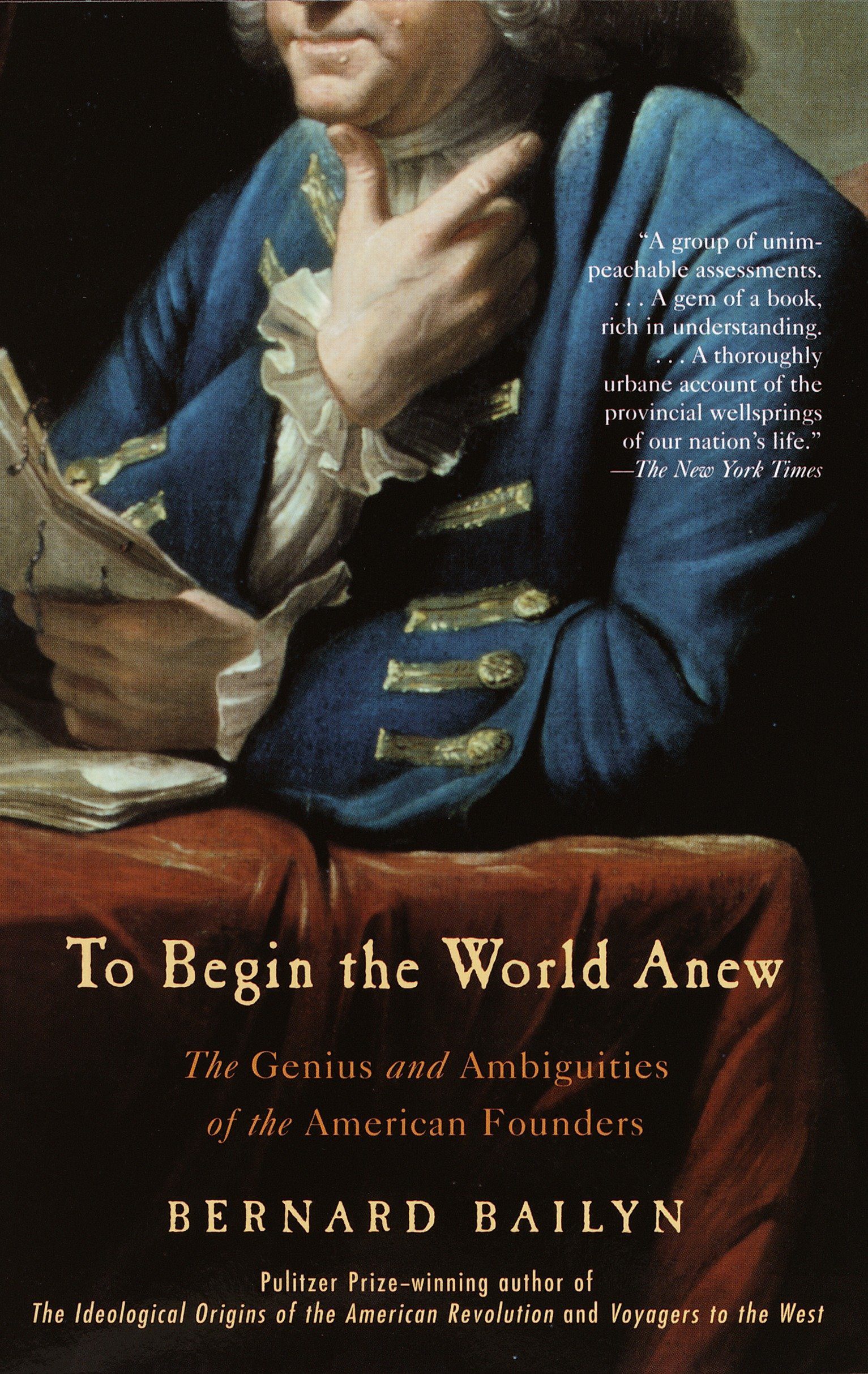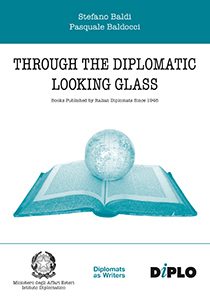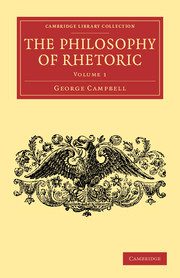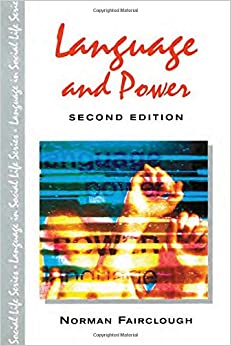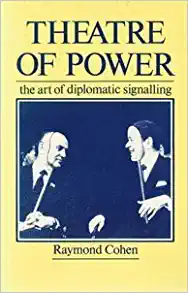Eloquentiam esse,…cuius fraude damnentur interim boni, consilia ducantur in peius, nec seditiones modo turbaeque populares sed bella etiam inexpiabilia excitentur…Quo quidem modo, nec duces erunt utiles nec magistratus nec medicina nec denique ipsa sapientia.1
M.F. Quintilianus, Institutio Oratoria, Book II, XVI, 2-5
Today I would like to talk about the simplest but the most important kind of historical rhetoric. I will talk about historical analogies that diplomats, decision-makers in foreign policy and executives frequently use to strengthen their arguments or make their views broadly acceptable. I will talk about the relation between diplomacy and the use of historical analogies and I will also talk about the attitudes that enlightened and intelligent diplomats should take towards this kind of rhetoric.
Historical analogies are a variety of metaphorical expressions that use an image of the past to shed some light on present or future affairs of mostly political concern. As metaphor represents an overlap between a source-analogue (is the sun) and its target-analogue (Juliet), historical analogies represent an overlap between an image of the past (source) and an image of the present or future (target).
- For instance, Hitler looked at the ways the British ruled over their Indian colonies to gain a better understanding of the ways he hoped he could rule over Europe.
- He thus created an overlap between a historical image of a past historical experience (the source of this piece of Hitler’s historical rhetoric) and an image of the future (the target of this piece of Hitler’s historical rhetoric).
Let me provide you with a few more recent examples to demonstrate that the use of this type of rhetoric is of relevance to contemporary international affairs and diplomacy as well. 2. In early 1997 US President Clinton compared the destiny of China’s economy with the fall of the Berlin wall. Clinton said that liberalisation of China would happen as inevitably as the Berlin wall fell.3 3. After the November 1999 OSCE conference, US President Clinton commented on Russian resistance to the international community’s attempts to interfere in the issue of Chechnya. “Clinton recalled the `thrilling experience’ of watching Mr. Yeltzin defy the junta that seized power in Moscow in August 1991 and then courteously asked would the West have been wrong to `interfere’ in Russian affairs and stand up for Mr. Yeltzin if the coup leaders have jailed him?”4 4. Again, on the Russian offensive in Chechnya, the International Herald Tribune commented: “Grigori Yavlinsky, one of the few Russian politicians with the courage to criticise the war, has used the analogy of Israel whose crushing military victories and territorial occupations led to decades of terrorism before it finally faced reality and struck deals with its enemies.”5 5. As the aforementioned analogy refers to Israel, here is a quote from former Israeli Prime Minister Netanyahu’s 1998 interview with Newsweek. Asked to comment on his then strained relationship with the Clinton administration, Netanyahu said: “Over the years we have had divided views between US presidents and Israeli prime ministers on Israel’s security needs. We had Eisenhower and Ben-Gurion differing on the Sinai; Ford differing with Rabin during the reassessment in 1975; Ronald Reagan and Begin clashing over Lebanon…In comparison to those disagreements, this is…a milder case.”6
6. Iranian President Khatami, in his famous CNN interview in early 1998, delivered several historical analogies. At the very beginning of this interview he delivered his key analogy of Puritan Mayflower immigrants coming to America. He said that the Puritan immigrants reconciled the idea of liberty with their religion, something many US governments have fallen short of, and added that Iranian post-revolution society has also been working towards such reconciliation. 7. Or let us take a few examples from the area of former Yugoslavia. While speaking about Bosnia, late Croatian President Tudjman frequently used the image of former Yugoslavia, which disintegrated after 1992. Tudjman drew an analogy between the destiny that, on one hand, befell the multi-ethnic state of Yugoslavia due to its multi-ethnic character, and the destiny that, on the other, he expected would befall the multi-ethnic state of Bosnia. 8. Prior to his departure from the post of Austrian Ambassador to Bosnia, Ambassador Valentin Inzko compared today’s Bosnia with post-World War II Austria, which he said was, like Bosnia, divided into several internationally managed sectors.
Well, I could keep expanding the list of examples forever, but I believe that the eight examples I mentioned above give a sufficiently clear idea of what I am going to talk about.
I owe you a few words about the detail that motivated me to focus more intensely on the issue of the use of historical rhetoric in diplomacy. Back in September 1995 US Ambassador Holbrooke started his diplomatic mission in and around Bosnia by negotiating an end to the Bosnian Serb army siege of Sarajevo. In Belgrade, on 13 September, Holbrooke met Milosevic, who told him that he could negotiate an end to the Sarajevo siege directly with Radovan Karadzic, the then president of the Bosnian Serbs. As Holbrooke recounts, he told Milosevic that he would accept meeting Karadzic together with a few other Bosnian Serb negotiators under two conditions: first for the Bosnian Serb negotiators to be under Milosevic’s tight control throughout negotiations, and second, for them to stop giving the US negotiating team “a lot of historical bullshit, as they have with everyone else”.7
In contrast with this 13 September 1995 episode involving Karadzic, in 1999 we find Holbrooke delivering an address to the national press club on his concept of “new realism” in US relations with the UN.8 Holbrooke opened his address with a reference to history; to the original vision of the founders of the UN, Franklin Roosevelt and Winston Churchill, who Holbrooke says provided clear guidelines for future US relations with the UN. So in one instance Holbrooke expressly condemned thinking in historical terms and called it “historical bullshit”, while in another he himself heavily relied on historical rhetoric to make his case more convincing. This is a paradox of sorts and it opens a number of dilemmas. How is it possible to endure dealing with negotiators who are so completely obsessed with history that their negotiating partners feel relief after their departure from the negotiating table? Is historical rhetoric just a repository of irrationalities that impede negotiations and lead to misunderstandings? If yes, then is it possible to get rid of historical rhetoric altogether? Does Holbrooke’s “double standard” in his successive judgments on a historical kind of diplomatic arguments stem from the fact that in the first instance he had to deal with selected chapters of Bosnian Serb history, while in the other he simply picked from a selected menu of his own national history? Was Holbrooke’s application of this double standard an example of a contradictory and self-defeating attitude towards historical rhetoric? If yes, does this reveal a kind of deeper logic in the use of historical rhetoric in diplomacy and negotiations? All of these questions are very inspiring and in my talk I will try to provide, if not straight answers, then at least a sense of the direction in which we should search for them.
Let me then start by explaining the reasons why historical analogies are used in the first place. This will give us a broad idea of the position that historical analogy occupies in psychological dynamics of both nations and individuals and, consequently, an equally broad idea of the roles that it plays in the world of diplomacy and international relations.
MEANING AND PURPOSE OF HISTORICAL ANALOGIES
First, historical analogising is an essential part of national narrative and national identity. Nations tend to group around their most central and deeply rooted memories. Over time many of those memories acquire the status of lasting symbols that nations use to describe their contemporary concerns or fears as well. A sound explanation of the domination of such symbols (i.e. historical analogies) in a nation’s self-understanding says that they help people symbolically transcend the limitations of time and space.9 Application of such analogies to a plethora of past and present conditions stretching over many centuries shows their symbolic ability to transcend temporal limits. In the same way many members of a nation probably feel that by embracing these symbols, they too can cross the boundaries of time and space and enjoy “secular” immortality. Now the illusion of immortality may be just that – an illusion, but few people are strong enough to resist its emotional appeal. That is why the need for spiritual transcendence is one of the main sources of motivation for the use of historical analogies in dealing with international affairs.10
The second function, which is directly linked to the aforementioned one, is the function of identity maintenance. Historical rhetoric not only provides nations with the sense of worldly immortality; a surrogate of religion, but also with an answer to the question “Who are we?” Historical rhetoric explains the lasting origins of a nation. Typically, when a crisis occurs in the life of nation, responses to it are couched in a language of past models, of past dealings with a crisis similar in shape if not in essence. When a president says that the nation must look to its past for a vision and inspiration to guide its present choice, he actually says that if applied to the present, models from the past will help the nation maintain its spirit and sense of specific identity. Not only does this process preserve the identity of a nation, but it also makes that identity more persistent. Russian child psychologists found long ago that a child provided with an imaginative stage to perform his/her role in experiments performed better than a child not provided with one. For instance, a child asked to stand still for a period of time will perform better if he/she understands his standing as playing the role of guard. The same applies to nations, which probably perform better if and when their actions are surrounded with the flavour of an imagined narrative-scenario; if their actions represent parts of a grander historical narrative and are built on models from their past.11 So historical analogies also originate from the need to maintain a group sense of identity.
A third function of historical analogy is simply to provide a sense of cognitive orientation in international affairs. The future is always open and undetermined, and the number of international actors and the complexity of their relations are too high to give a straight clue about future developments. And here is where historical analogies play a crucial role. They indicate a direction for actions in this world, which would otherwise remain too complex to allow for an intellectual grasp. Historical analogy simply projects an image of past developments into the future and thus makes the future cognitively manageable. For instance, when former Yugoslavia entered into the period of crisis and increased turbulence, its future was easier to grasp for those who had, or thought they had, a historical analogy to rely on; a precedent to guide their understanding of Yugoslavia’s future course. Making a choice or prediction is easier when one is in possession of a recipe, and historical analogies provide such a recipe.12
Finally, historical analogies could be used as a kind of anti-depressant; a colourful imagery which neutralises a boring and non-dramatic kind of political reality. Historical analogies make international relations intriguing, interesting, worth watching and participating in, which without such a drama-producing imagery would not be the case. They put things and relations, as it is said, into perspective and make them tastier, less boring and more purposeful. Historical rhetoric sets a scenery or stage linking the past with the present and the future into the chapters of a single drama to offset the bad feeling that nothing important or big is happening.13
So far so good. Historical analogy makes sense, as it performs several important functions and occupies an important place in the mental dynamics of individuals as well as of nations. Diplomats are not only expected but also welcome to use it. History is like a big bag from which a diplomat may grab an analogy whenever a recipe to provide cognitive orientation is needed. History is like a grand story, which will endow a diplomat with a sense of national identity, a sense of the coherence of the events that shape the course of a nation’s development; something to remind a diplomat of the universality and endurance of the nation’s interests. History is also like a rich set of colours which help diplomats recover the meaning and purposefulness of the field of international affairs with which they deal. Something that allows them to paint that field in more attractive colours, to refresh their jobs and provoke the interest of others. But…
CAVEAT FOR DIPLOMATS
Historical rhetoric has undeniably played an important causal role in the etiology of many conflicts that have brought immense suffering and misery to many nations. Let me give you a few examples:
1. One of the causes of World War I was the Agadir crisis, which made the German Kaiser less flexible and readier to fight than would have been case had the crisis not taken place. The reason the crisis made the Kaiser more rigid and bellicose is that the German public quickly compared the outcome of the Agadir crisis with the “Olmuetz 1850” crisis, which resulted in Prussia backing down from a confrontation with Austria; regarded as a devastating humiliation for Prussia. So, the two crises merged into a single historical symbol of a blow to Germany’s sense of honour, imposed a historical analogy, and, it is generally believed, made Germany readier to push Austria-Hungary to declare war against Serbia.14
2. One of key causes of World War II was the historical analogy of World War I, which made both French and British leaders reluctant to take a more aggressive stance towards Hitler. When Hitler decided to remilitarise the Rhineland the French reacted in an astonishingly mild way, because their thinking was dominated by the analogy of disastrous World War I French offensives, which inflicted too heavy losses on the French army. The then British Prime Minister Chamberlain himself treated Hitler as if he was a replica of the German Kaiser. Thus, the famous “appeasement” strategy was an effect of Chamberlain’s historical analogising.15
3. Prior to launching an action in Vietnam, US President Johnson’s thinking was guided by the analogy of the failed Munich “appeasement” strategy as well as by the analogy of the Korean War, in which the US, with some setbacks, finally achieved success.16
4. When Clinton presented his reasons for the NATO military action on Kosovo in March last year, he described them in terms of World War II and drew an analogy between Hitler and Milosevic. He pointed out that Milosevic would like to have a mono-ethnic Kosovo cleansed of Albanians, just as Hitler wanted to create a mono-ethnic Germany cleansed of Jewish, Polish and other “inferior” nations. So, Clinton’s historical rhetoric helped him link American past engagements with his own latest decision to wage a military action and provide it with a deeper purpose.17
5. I also believe that another seemingly innocent analogy indirectly led to the NATO action. This was the analogy drawn between the Dayton peace negotiations and the Rambouillet negotiations.18 This analogy probably made international mediators in the conflict between Kosovars and Serbs too optimistic and hasty.
6. The 1980s war between Iran and Iraq as well had important historical analogies in the cluster of causes leading to its outbreak. Iraq used the analogy of the 636 battle of Qadisiya in which the Arabs stopped a Persian invasion. Iran used the analogy of Sunni military commander Yazid, whose troops ambushed and killed Mohammad’s grandson Hussein in 680. That is why the Iraqis called one of their offensives the “second battle of Qadisiya”, and called the war against Iran “Saddam’s Qadisiya”, while Iranians called both Iraqis and Americans in general “successors of Yazid”.19
7. Historical analogies played an essential role in the events leading to the series of wars in former Yugoslavia. Parties to those conflicts frequently used analogies of World War II and compared successor states’ leadership with either Ustasha leaders from World War II or Chetnick leaders from World War II. During the recent Bosnian war, the myth and the analogy of the Kosovo-field battle at which the Ottoman Empire opened the door to its further conquest of Serbia and Bosnia, was frequently relied on to justify Bosnian Serb political objectives. Of course many other examples could be mentioned, but I selected those few from the wars that we are all very familiar with.
The examples I enlisted reveal several patterns by which historical analogies partake in the chain of causes leading to lethal conflicts.
First, a contemporary state or leader may be directly compared to a belligerent leader; a thug who played a key role in a past crisis or conflict. Then those using such an analogy usually take the role of a defensive alliance, or the leaders or states that opposed the past aggression.
Second, historical analogy may exert an indirect influence and simply bring a nation or a leader closer to making the decision to wage a war. For instance, the “Olmuetz” analogy made it near to impossible for the Kaiser to tolerate challenges to Germany’s sense of honour any longer. And then when Duke Ferdinand of Austria-Hungary was assassinated, Germany interpreted this as another blow to Germany’s sense of honour, decided to punish Serbia, and thus directly instigated World War I. Here historical analogy played the role of a factor that in fact accelerated the accumulation of background causes of the war.
Third, historical analogy may convince a leader to take a too defensive posture and to fail to act at times when action is the only means to deter aggressors and prevent a bigger crisis from erupting.
In other words, historical analogising sometimes leads to an overly offensive, self-confident posture. It sometimes leads to a significant lowering of the threshold of tolerance as it negatively affects self-image, i.e. sense of honour. And last but not least it sometimes plays the role of a deterrent to deterrence and makes leaders too restrained, too cautious in acting, which then gives an opportunity to belligerent leaders of this world to pursue their own policies. For instance, French leaders were reluctant to make an offensive move against Hitler because a) their image of World War I implied that offensive equals disaster; and b) because they did nothing to question the applicability of that source-analogue to the future developments they expected in their relations with Hitler.
It is also interesting to note that, following Dessler’s typology of causes of wars, historical analogy may be found playing the role of any of Dessler’s four types of causes. Historical analogy may act as trigger of war, as a channel of division which sets background conditions for the outbreak of war, as a target defining objectives of the parties to a conflict, and also as a catalyst which determines the intensity and duration of a conflict.20
There is yet another factor worth mentioning. The historical analogies that the very parties to a conflict use are not the sole and exclusive determinant in the conflict’s etiology. The historical analogies that third parties use are as well of extreme relevance and importance for both origins and dynamics of conflicts. For example, during the war in Bosnia the historical analogies that the US decision-makers employed in the period of 1993 to 1995 definitely had an impact on the very parties to the war as well as on the course of the war.
It is thus clear that relations between nations may worsen considerably because developments are prejudged by the use of historical analogies. Instead of reducing the complexity of periods of crisis, historical analogies make complexity even higher. It is to an extent ironic that historical analogies, which are supposed to bring more order and simplicity into our images of international developments, instead lead to an increase in complexity. They turn relations into a powder keg, as the famous metaphor has it.
Another half-ironic or paradoxical side effect is the fact that although at the beginning of this presentation I referred to four functions that historical analogies perform which seem to make our use of them very meaningful, we seem now to have reached the very opposite conclusion. Historical analogies are among the key causes of war and that is why one could rightly argue that they cannot provide a sense of transcendence or of worldly immortality. How can they, when they lead to the very concrete extinction of many individuals supposed to enjoy the sense of transcendence and hover above distant periods of history by means of historical analogy? They cannot provide a sense of identity either. How can they, when they have so often led to clashes between identities? They cannot provide a sense of cognitive orientation either. How can they, when instead of bringing more simplicity and order into our minds, all they bring is actually disorder and chaos in the times of war?
My first reaction to this paradox was as extreme as anyone’s reaction is likely to be. “Let us dismiss historical rhetoric completely!” “Let us ban it!” “Let us tell leaders and/or diplomats to resist the temptation of thinking in terms of historical imagery!” They must not look backwards but forwards. They must not compare new crises with past sections of their or anybody else’s history. Diplomats must not use the language of historical analogies. They should do their best to resist temptation to describe current crises in terms of the past. Instead, diplomats should maintain the good old tradition of ambiguous language; of polite language which gives equal consideration to the interests of all the parties concerned with, and involved in, a critical process. Such an argument for a ban on the use of historical rhetoric would further add that diplomacy is an art of making compromises that by definition provide ambiguous resolutions to conflicts. And such an argument would further add that the art of diplomacy requires a creative individual capable of transcending established and standardised patterns of thought and action, including historical ones. That is why diplomats, who serve as balancing communicators between groups or nations, are to be advised to use ambiguous expressions and language, which allows room for satisfaction of several interests at once and suggests no clear direction in which one should move. Ambiguous language prepares one for accommodation, creates distance from a priori defined commitments/interests, and thus by implication reduces the potential for conflict.21 Simple but suggestive and dangerous historical metaphors create a risk of increasing the complexity in the relations between actors in a diplomatic process. Complicated but flexible and polite ambiguities tend to reduce such complexity. This seems to be a paradox but it actually should be considered the number one rule for language that diplomats use in times of crisis or stress. So, the argument runs, diplomats should cross out historical metaphors from their dictionary and take ambiguities as their main tool for coping with potentially explosive situations in which their nations may feel tempted to release ancient ghosts.
I must admit this is a great argument. And it seems to be a natural reaction to the fact that the use of suggestive historical metaphors is de facto one of the causes of conflicts. But…
CAVEAT GONE WRONG
Despite the argument, and the unmistakably clear recipe it provides, historical rhetoric and description of the present in terms of the historical past are not so easy to dismiss. Two reasons, combined, cast tremendous doubt on the belief that diplomats may simply do without the use of historical analogies in dealing with international affairs.
First, the human mind has a biological inclination to reason inductively; that is, to reason about future happenings through the prism of past experiences. We reason via analogies. By instinct we set expectations on the basis of our past experience and nothing may be changed with that. So if we have a certain historical experience, as we all have, then images of our future are bound to have their roots in that experience.22 That is why historical rhetoric is not just an occasional propaganda tool for politicians, or a specialty of those who are obsessed with the past, but an ever-present and persistently recurring phenomenon.
The second reason holds that the world community is divided into nations with each nation measuring the time of its existence along the historical line of its evolution. And each nation considers its historical traumas and recoveries especially important; something like milestones on the path leading from its past to its present. Nations thus treat their particular histories as stores of their collective memory, which serve both the purpose of maintaining their particular identities and the purpose of providing answers to challenges of the present time. Diplomats are still their nations’ humble servants and therefore cannot avoid using historical analogies in presenting their nation’s views or interests. Look at what happened to Holbrooke!
That is why a total ban on the use of historical rhetoric has no chance to hold. Despite our suggestion to diplomats not to reach into the bag of historical metaphors while selecting the style of their wording and language, their hands will instinctively go there. This means that we must discover more cunning ways of dealing with this instinct.
A common-sense view would suggest that diplomats should choose a “golden mean”, and try to balance and combine certain aspects of both historical rhetoric and ambiguous language in order to satisfy their instincts but also to make this satisfaction less dangerous, less capable of generating first mental and then armed conflict. In other words, diplomats may continue using historical analogies but they should be made more ambiguous and less suggestive. This would imply taking a different approach to history as well as to the historical rhetoric that diplomats cannot escape using. Since, as we saw, historical rhetoric takes the form of suggestive historical metaphors, this means that diplomats should try reshaping the ways in which they map the source-analogue of a metaphor (an image of the past) onto its target (an image of the present or the future). For a diplomat, selection of language and style is extremely important, and the goal should be the creation of a new kind of historical “Diplomatese” language combining both narrowly historical and narrowly diplomatic considerations, and borrowing from both “make it ambiguous” and “make it historical” schools of thought.
“DIPLOMATESE” STYLES OF AMBIGUATION AND MODERATION OF HISTORICAL RHETORIC
My firm belief therefore is that a diplomat has the freedom of choice. I do not believe that diplomats must rely exclusively on suggestive historical rhetoric, or, on the other hand, ban it completely. They are free to choose a more refined language of their own making; a language which would meet the demands of identity and continue to perform the four functions that historical analogies perform, but which would at the same time open some doors to ambiguities and help diplomats communicate more efficiently and less stressfully in times of crises.
The idea is very simple. All we have to do is to loosen the link between a source of historical metaphor and its target. In that way a diplomat could still retain a historic image, an idea of historic precedents, using language which would also retain the flavour of national identity or national narrative. By using ambiguated historical analogies, though, diplomats could, with the same stroke, raise their awareness of the fact that the final decision is theirs to make, as the “loose” historical analogising would leave enough elbow room for them to act as individual and adaptable thinkers or decision-makers. Namely, ambiguated historical analogies do not deduce from the past a straightforward or rigid image of the future.
I will present here six different methods of ambiguation of historical rhetoric but I believe that one could and should think of more.
First, one could do what General Semantics advises us to do.23 Instead of using an image of trends, periods, or any suchlike generalities, the diplomat should use an image of a particular moment in history as a source-analogue of historical rhetoric. So, instead of saying simply that Saddam is like Hitler, the diplomat should focus on a particular moment of Hitler’s political biography, comparing that very moment with the current moment in dealing with Saddam. I call this method “the method of particularised rhetoric“. Its effects are indeed incredible. The first thing you will notice is that historical analogy becomes much more complicated, much more demanding, but at the same time it opens numerous cognitive possibilities in detailed thinking on one’s future choice vis-à-vis Saddam.
Second, instead of using clean and straight images of the past, diplomats should try making them more blurred and grey. For instance, while comparing China with the former Soviet Union, an American diplomat should think of the USSR not only as a former ideological enemy but also as a challenge, which may have caused or helped the US to achieve several breakthroughs in science, economics or technology. Or the diplomat could think of the USSR as a state which the US indirectly drained during the cold war period and is therefore partly to blame for the poverty plaguing today’s Russia. I call this method “the method of blurring rhetoric”.
Third, instead of using an image of past actualities as the source of historical analogy one could use an image of past potentialities. This usually goes under the heading of history of missed or lost opportunities, but it should include a history of the risks that states or leaders were lucky to escape as well. So a diplomat should not use only actual achievements or happenings as a paradigm, but rather all the things that were either luckily escaped or nearly achieved but missed, due to short-sightedness, unexpected occurrences, or misleading information. Instead of comparing Yeltsin with Hitler, we may better start thinking of the opportunities that pre-World War II European governments missed in their dealings with Hitler, of the potential past in which Hitler may have taken a different path had the governments acted in a way they did not.24 Again, you see that the link between potential past and the actual present becomes somewhat ambiguous and that the rhetoric thus generated places all responsibility for future actions on the diplomat using it. Such imagery linking potentialities and actualities requires an active effort on part of the diplomat and makes it impossible for the diplomat to hide behind a suggestive comparison which may lead decisions in a predetermined direction. I call this method “the method of fictional realism in rhetoric”.25
Fourth, in some periods of history actions taken led not to the preferable or desired objectives but to their very opposites. It seems as if the action produced an accumulated net-side-effect, which reversed the very action, undid it and delivered the least rather than the most desired thing. In theories of tragedy this is called “tragic irony” but the message is, I believe, sufficiently clear: humans sometimes take actions blindly believing they will deliver a happy outcome. Humans though are too ignorant to accurately predict all the factors playing an important role in the actual course of their actions and that is why their actions sometimes return to them like a boomerang. Every nation has probably experienced history’s tragic ironies and the story of an age when success was almost achieved but then a disaster followed is a typical chapter in national narratives. Now, my idea is to use those bits of tragically ironic history as sources of historical analogies. This would remind both decision-makers and diplomats of the shortcomings of any grand design; of the fundamental inability of human beings to predict all the factors determining the outcome of an action. Instead of using plain historical analogies predicting more or less clear outcomes, let us use those analogies that speak about unpredicted and unpredictable details that have reversed the course of history and may reverse it once again. I call this method of ambiguation of historical rhetoric “the method of ironic rhetoric”. And if the diplomat ever decides to play the role of advocatus diaboli (devil’s advocate) to improve the quality of group decision-making considerably, this is the best way to look at history as a fount of historical rhetoric.26
Next comes method five. While all previous methods focus on the quality of the source and the target of historical metaphors and the link between the two, this method focuses on quantity. Instead of using a single image of the past as the source of metaphorical representation of the present or future, we may better use many images. That means that instead of swaying under the temptation to compare today’s China with the former Soviet Union, we may better compare China to many other historical paradigms as well. In that way we will loosen the link between the target (China) and the source (former Soviet Union and others), make it more ambiguous, while at the same time we will enrich our base of decision-making and better prepare ourselves for several distinct possibilities. The likelihood that the future will literally quote the past is infinitely low, however unambiguous suggestive historical metaphors lead one to believe that the future will reproduce the past fully. Using a multitude of sources in historical analogy runs counter to that tendency and, like the aforementioned methods, secures adaptability of thought to unexpected circumstances. I call this method “the method of multiplied rhetoric”.27
The sixth method itself concerns the quantity of targets and sources. Instead of a simple focus on the source, this method focuses on both source and target and proposes the use of dual sources and dual targets. That means that instead of drawing a parallel between, for instance, Saddam and Hitler, one should draw a more complicated parallel between two relations; between the relation holding between Saddam and the US of today, on the one hand, and the relation holding between Hitler and the US in, let us say, 1940, on the other. The first thing one would notice is that this latter parallel does not sound very convincing. The reason for this is that analogies drawn between simple entities may be based on superficial similarities, but those between relations are more demanding because relations themselves are abstract concepts and thereby more difficult to discern. So again, a historical rhetoric playing with relations is intellectually much more demanding and much richer in nuances than one playing with a single historical object as a source and a single contemporary object as a target. And this again is likely to make one more cautious in the choice of historical analogies.
Besides, relations are, so to say, floating above entities and no entity has full control over the relations that hold between it and another entity. And no relation is deterministically defined by the actions of a single entity. This is in itself a positive message on the use of relations as both source and target of historical rhetoric. I would call this method “the method of relational rhetoric”.
A sharp and sceptical eye would quickly identify seemingly weak spots in the methods I proposed.
For instance, the method of fictional realism would probably meet a suspicious critic arguing that potentialities are unfortunately only that – potentialities! That means that their status among mental entities (concepts, stories, stores of knowledge and alike) is bound to be somewhat insecure. Potentialities do not strike the way realities strike and that is why our memories do not adopt them easily as their most valuable treasures. Potentialities are floating and easy to forget and are difficult to transmit in the form of socially relevant and usable knowledge. For all those reasons the concept of fictional realism in rhetoric is, a suspicious critic would say, unlikely to take firm root among diplomats or historians. Besides, it seems that whatever positive diplomatic aspect the concept has it would evaporate once diplomats start asking the question “Who lost the opportunity?” too emphatically.
Or let us take the method of ironic rhetoric. A suspicious critic would probably counter-argue that the philosophy standing behind the concept of ironic rhetoric is too tragic to be given serious consideration. The concept of tragic irony seems to load too heavy a burden on human shoulders, both intellectual and emotional. It is deeply unsettling when one considers human history as a series of self-annihilating actions. It is too pessimistic, too hopeless for any thinker to endure for any length of time. People like toying with the idea of progress, of something that endows their lives with meaning and purpose. Since the concept of ironic rhetoric runs against that deeply human sympathy for an evolutionary world-view it would not generate enough resonance among diplomats of this world.
And, finally, the critic may say something like “Your methods of ambiguation are too elitist an endeavour! Leaders and foreign ministers need popular support and that is why they need to address the minds of common people, the common people’s needs, memories, concerns, fears, etc. Do you believe that a leader or state secretary would go and address his populace with such a tricky and intellectually too demanding version of historical rhetoric? Do you really believe that an ambiguated historical analogy would resonate in the minds of ordinary citizens?”
I could not fail to acknowledge the objections of the fictional critic. They are all in perfect order except that they may shatter my proposal only to a very limited degree. For instance, to use ironic rhetoric here and there does not imply subscribing to a radically pessimistic philosophy of history with no meaning and purpose. I mean to use it as an occasional reminder to avoid future tragedies and help others avoid self-defeating actions.
As regards potentialities and their insecure ontological position, I must admit that such an objection sometimes holds, but sometimes it does not. There certainly may be potentialities that we sometimes just fancy and that then swiftly go away. Some potentialities though are different; they do not go away and we think of them most of the time. For instance, the potentiality of me being hit by a car while crossing a street is not just a fictional one. And I believe that relevant historical potentialities belong to the latter category. If history has taken different and disastrous paths because a diplomat has missed an opportunity or did not timely recognise a potentiality, then someone should be thinking a lot about that opportunity. Concerning the question “who has lost an opportunity?” I believe that in this case unilateral assignment of responsibility is neither fair nor possible. It may be that, for example, the French failed to respond in time to the remilitarisation of the Rhineland, but those who directly or indirectly “helped” them fail should be held responsible as well.
As regards the critic’s concern with popular support I must admit that diplomacy is an elitist activity. My intention however was not to propose the six methods as a set of tools to help presidents in drafting public speeches. My intention was to propose them to enrich and better the decision-making process among the elite, primarily. As for presidents or foreign ministers, they themselves should find ways to build the methods into the messages they would like to deliver through public speeches. So I leave that to their skill and intelligence. Finally, the boundary between the elite and the populace is constantly shifting and the distance between the two depends on one sole factor; education, of which the populace should and does take care itself.
As a general point, the objections mentioned teach the lesson that one must not become a slave to a recipe. Once methods get fixed and stop evolving they turn into rigid tricks that an acute observer will quickly recognise as such. (A typical example of this is the famous rule of the use of “I-sentences” instead of “You-sentences” in negotiations.) Once our partner party to negotiations realises that we do nothing but read from a menu, from a closed list of methods and recipes, our stated positions are bound to lose half of their strength. The requirement of creativity, which says that we must constantly expand and keep innovating in our use of language, applies here as well.
Let me then at the end summarise the main points of my talk. First, when it comes to the use of language and its many styles, diplomats must bear in mind that they have a choice. They may choose one or more among many styles of language. This freedom of choice of an instrument of expression is particularly important because plurality of such instruments makes diplomats aware of their own responsibility in verbally expressing their attitudes towards international developments. Lack of awareness of plurality of such instruments makes an expressed attitude appear too natural and disables diplomats from making a reflective and conscious choice; from taking full responsibility for the effects of their choices. For instance, I demonstrated that historical analogising appears couched in at least two different styles of linguistic expression (pure analogies and ambiguous analogies), while awareness of its likely negative effects may give rise to another one, the style of an ambiguous use of language. And I also pointed to various motivational factors that may move a diplomat to opt for one or the other or any combination of these styles. This is highly likely to endow diplomats with the sense of control over what they may otherwise believe to be a spontaneous verbal expression of their natural psychic attitudes. It is pointless to advise diplomats that their verbal style should be polite or moderate unless they have been taught about plurality of possible verbal styles and about their advantages as well as disadvantages. Politeness or moderation in use of language is not a natural fruit growing on every tree.
Second, when it comes to the issue of conflicts, historical analogies play a causal role in the etiology of conflicts. However, I failed to say how important the role is and under what conditions the negative effects of historical analogising may be neutralised by other factors. One thing however needs to be taken for certain: it is better to be beforehand alerted to a factor that may play an important role in the etiology of conflicts. History has delivered many lessons on this and it is better for us not to rely on the vicissitudes of chance. Historical analogies come under the heading of psychological causes of war and I believe that they are indeed the underlying ones.
Third and finally, diplomats must be aware that they have freedom not only of choice but also of making a brand new language of their own liking. As I tried to sketch the basic elements of a new kind of historical “Diplomatese”, so every diplomat should try making a better and more expressive kind of Diplomatese. As Noam Chomsky repeated time and again, language consists of finite number of items (phonemes, dictionary entries, rules of grammar, etc.), but the number of possible combinations of those items is virtually infinite. Every day human beings produce novel metaphors never heard before. The diplomat must give serious consideration to this fact of creativity in language, to the ability of language to expand and adapt to all kinds of conditions.
Paraphrasing Hobes, Josef Joffe on one occasion said that diplomacy without a sword is but a word. The way I understand this metaphor, it implies that diplomats on all sides must be aware of their power to materialise their aims, and that without such awareness diplomacy would be just an empty and aimless exchange of words. The way I see things, diplomacy is primarily words that prevent us from reaching for our swords. That is why there must be no end to our attempts to improve the ability of our language to simulate real acting and thus to make swords dispensable. Making our words independent of swords, of which moderation or ambiguation of historical rhetoric is just one aspect, is one among many steps that diplomats must take to create through language a different and healthier atmosphere in international relations.
ENDNOTES:
1. (They argue that) eloquence/rhetoric from time to time secures the condemnation of the innocent, that it leads deliberations astray, that it causes not merely sedition and popular turmoil, but also wars beyond all expiation…But, following the same modus of thinking, not only orators but also magistrates and medicine and science itself would all be useless. (Quintilian, refuting the critics of rhetoric who, starting from the valid premise that rhetoric has been occasionally used to evil ends, wrongly concluded that rhetoric should be banished from Rome as it was banished from Sparta. Quintilian died in the year 96 AD).
2. Mark Mazower, Dark Continent: Europe’s Twentieth Century (Harmondsworth: Penguin Books, 1998), 150.
3. International Herald Tribune, 30 January 1997, 1.
4. The Economist, 27 November 1999, 35.
5. International Herald Tribune, 1 December 1999, 8.
6. Newsweek, 20 April 1998, 38.
7. Richard Holbrooke, To End a War (New York: Random House, 1998), 148.
8. Richard Holbrooke, A New Realism for a New Era: The U.S. and the UN in the 21st Century [website]; available at https://www.un.int/usa/99_103.htm.
9. See, for instance, Anthony D. Smith, Nations and Nationalism in a Global Era (Cambridge: Polity Press, 1995), 160.
10. Though all historical analogies simultaneously perform all four functions I am talking about, some of them lay more and some less emphasis on specific functions. For instance, example number 6 on page 6 below is an analogy which lays emphasis on the function of “spiritual transcendence”.
11. Example number 5 from page 1 above is a good example of a historical analogy which emphasises the function of identity maintenance.
12. Examples number 4 from page 1 above and number 8 from page 2 above are good examples of historical analogies which emphasise the cognitive or predictive function.
13. For instance, the “Greece to their Rome” analogy in which Great Britain plays the role of Greece to the twentieth century’s Rome, i.e. the USA, was used by many influential policy and opinion makers in post-imperial Britain to offset bad feelings following the decline in Britain’s global influence. For an excellent study of the history of the analogy and its ironies, see Christopher Hitchens, Blood, Class and Nostalgia (London: Vintage, 1990).
14. Donald Kagan, On the Origins of War and the Preservation of Peace (New York: Anchor Books, 1995), 173-174.
15. Ibid., 376 and 414.
16. Richard E. Neustadt and Ernest R. May, Thinking in Time (New York: Free Press, 1986), 87.
17. See President Clinton’s statement in Washington Post, 24 March 1999, A1. See also an article on Clinton’s analogy: Jonathan Alter, “The Trouble with History,” Newsweek, 12 April 1999; and Henry Kissinger, “Doing Injury to History,” Newsweek International, 5 April 1999.
18. Wolfgang Petritsch, Karl Kaser, Robert Pichler, Kosovo-Kosova (Klagenfurt-Wien: Wieser Verlag, 1999), 278.
19. I owe thanks to Russian Ambassador Alexander Zotov from the Sarajevo Office of the High Representative for helping me better understand this analogy as well as for preventing me from committing at least one factual error.
20. David Dessler, “How to Sort Causes in the Study of Environmental Change and Violent Conflict,” in Environment, Poverty, Conflict, ed. Nina Graeger and Dan Smith (Oslo: International Peace Research Institute, 1994), 91-112.
21. Applied to the 1995 episode involving US Ambassador Holbrooke and then Bosnian Serb leader Karadzic, it seems that what annoyed Holbrooke most was the fact that the historical rhetoric that Karadzic frequently used to support his arguments tended to commit him to a too rigid bargaining position. In contrast to ambiguous language, historical analogies are very suggestive of the direction that one should take and do define one’s commitments too tightly.
22. See the excellent case-study by David Patrick Houghton, “The Role of Analogical Reasoning in Novel Foreign-Policy Situations,” British Journal of Political Science 26/4 (October 1996): 523-552. Houghton shows that foreign policy decision-makers, though aware of the fact that the situation they face is novel, i.e. unprecedented, cannot escape relying on historical analogies throughout the decision-making process.
23. For a comprehensive overview of Korzybski’s General Semantics, see Frank J. Bruno, Adjustment and Personal Growth: Seven Pathways (New York: John Wiley and Sons, 1983), 167-176. For a method of the use of history similar to the method of particularised rhetoric, see Neustadt and May, Thinking in Time, 105-107, on the “Goldberg rule”.
24. Actually, in December 1993 the president of Kazakhstan, Nursultan Nazarbayev, came very close to comparing Yeltsin with Hitler. For details, see Foreign Affairs (May/June 1994), 109.
25. For an example related to the issue of Palestinian history, see Anders Sandvig, A Joint Nordic Centre for Peace in Jerusalem, (Oslo: Courage, 1993), 46-54. Kagan, On the Origins of War, is itself written under the mark of the concept of lost opportunities. For an excellent example of a historical analogy using “the method of fictional realism” and setting an ideal, see the third example on page 1 above.
26. As regards “ironic rhetoric”, Henry Kissinger seems to have a lot of sympathy for this kind of historical narration; almost all of his writings on history include many examples of tragically ironic episodes. Furthermore, a wonderful example of tragic irony resulting from the use of historical analogy is found in Edward H. Carr, What is History? (London: Penguin Books, 1990), 71. As the story goes, “The Bolsheviks knew that the French revolution ended in a Napoleon and were afraid that their own revolution might end in the same way. They therefore mistrusted Trotsky, who among their leaders looked most like a Napoleon, and trusted Stalin, who looked least like a Napoleon”.
27. This method was proposed in K. J. Holyoak and P. Thagard, Mental Leaps (Cambridge: MIT Press, 1995), 163.


